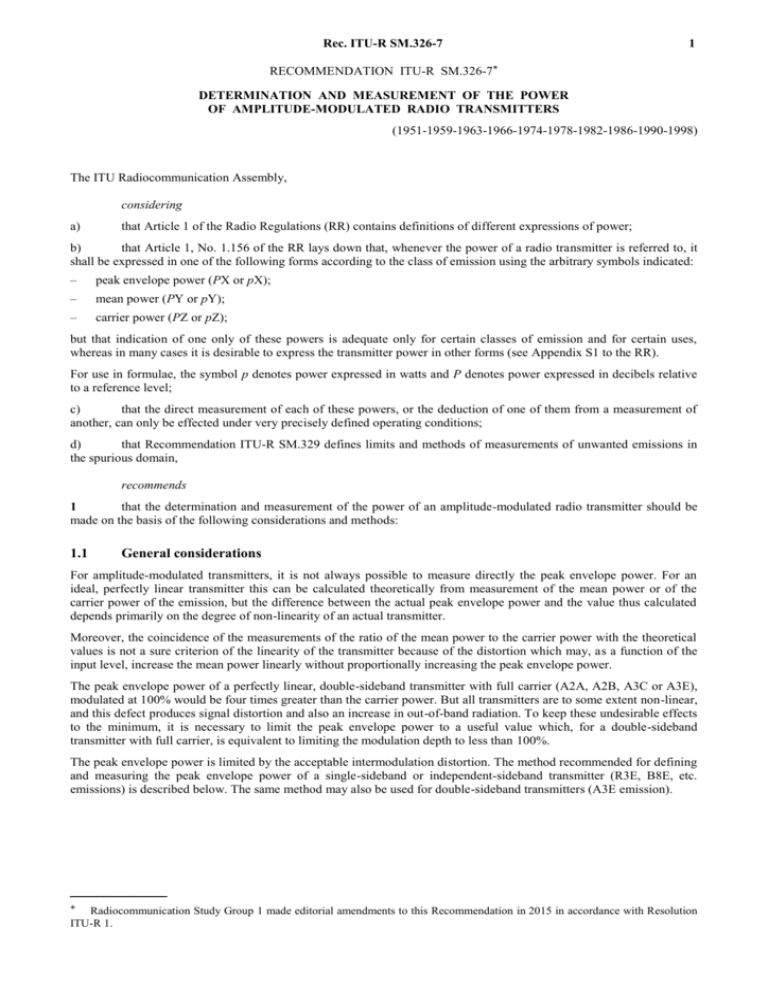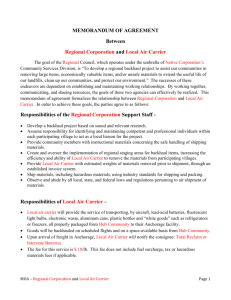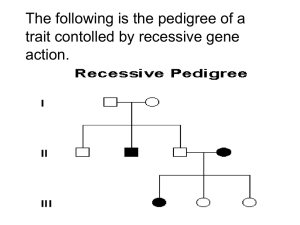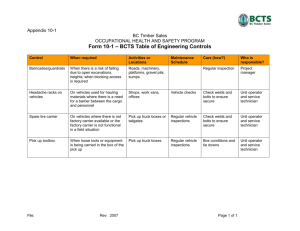SM.326-7 - Determination and measurement of the power of
advertisement

Rec. ITU-R SM.326-7 1 RECOMMENDATION ITU-R SM.326-7* DETERMINATION AND MEASUREMENT OF THE POWER OF AMPLITUDE-MODULATED RADIO TRANSMITTERS (1951-1959-1963-1966-1974-1978-1982-1986-1990-1998) Rec. ITU-R SM.326-7 The ITU Radiocommunication Assembly, considering a) that Article 1 of the Radio Regulations (RR) contains definitions of different expressions of power; b) that Article 1, No. 1.156 of the RR lays down that, whenever the power of a radio transmitter is referred to, it shall be expressed in one of the following forms according to the class of emission using the arbitrary symbols indicated: – peak envelope power (PX or pX); – mean power (PY or pY); – carrier power (PZ or pZ); but that indication of one only of these powers is adequate only for certain classes of emission and for certain uses, whereas in many cases it is desirable to express the transmitter power in other forms (see Appendix S1 to the RR). For use in formulae, the symbol p denotes power expressed in watts and P denotes power expressed in decibels relative to a reference level; c) that the direct measurement of each of these powers, or the deduction of one of them from a measurement of another, can only be effected under very precisely defined operating conditions; d) that Recommendation ITU-R SM.329 defines limits and methods of measurements of unwanted emissions in the spurious domain, recommends 1 that the determination and measurement of the power of an amplitude-modulated radio transmitter should be made on the basis of the following considerations and methods: 1.1 General considerations For amplitude-modulated transmitters, it is not always possible to measure directly the peak envelope power. For an ideal, perfectly linear transmitter this can be calculated theoretically from measurement of the mean power or of the carrier power of the emission, but the difference between the actual peak envelope power and the value thus calculated depends primarily on the degree of non-linearity of an actual transmitter. Moreover, the coincidence of the measurements of the ratio of the mean power to the carrier power with the theoretical values is not a sure criterion of the linearity of the transmitter because of the distortion which may, as a function of the input level, increase the mean power linearly without proportionally increasing the peak envelope power. The peak envelope power of a perfectly linear, double-sideband transmitter with full carrier (A2A, A2B, A3C or A3E), modulated at 100% would be four times greater than the carrier power. But all transmitters are to some extent non-linear, and this defect produces signal distortion and also an increase in out-of-band radiation. To keep these undesirable effects to the minimum, it is necessary to limit the peak envelope power to a useful value which, for a double-sideband transmitter with full carrier, is equivalent to limiting the modulation depth to less than 100%. The peak envelope power is limited by the acceptable intermodulation distortion. The method recommended for defining and measuring the peak envelope power of a single-sideband or independent-sideband transmitter (R3E, B8E, etc. emissions) is described below. The same method may also be used for double-sideband transmitters (A3E emission). * Radiocommunication Study Group 1 made editorial amendments to this Recommendation in 2015 in accordance with Resolution ITU-R 1. 2 Rec. ITU-R SM.326-7 1.2 Intermodulation 1.2.1 Principle for the measurement of intermodulation distortion The imperfect linearity of amplitude-modulated radio transmitters can be expressed as a function of the level of the intermodulation products. To determine that level, it is convenient to measure separately the amplitude of each intermodulation oscillation resulting from the application, at the input of the transmitter, of two periodic modulating sinusoidal oscillations with frequencies f1 and f2. For the sinusoidal exciting oscillations at frequencies f1 and f2, the frequency of the intermodulation component at the output of the transmitter is given by the formula: F p ( F0 f1 ) q ( F0 f2 ) with p, q 1, 2, 3, etc. (1) where: F0 : carrier frequency f1 and f2 : frequencies of the exciting oscillations. The positive sign between the two terms of the sum corresponds to much higher frequency oscillations with, as a general rule, very low amplitudes; this case is of minor interest for the purpose of this Recommendation. 1.2.2 Choice of frequencies for modulating oscillations To measure the amplitude of the intermodulation products, it is desirable to use modulating oscillations having frequencies near the limits of the audio-frequency passband. The audio-frequency passband to be considered here is the band at the input of the transmitter which corresponds at the output, to the whole of a sideband of an emission. Harmonics and intermodulation components, mainly of even order, may originate in the low-frequency equipment at the input of the transmitter or during the processes of modulation. To prevent these coinciding or interfering at the output of the transmitter with the intermodulation components of the third and the fifth order to be measured, the modulating frequencies f1 and f2 should be chosen carefully. A harmonic relation between the modulating frequencies f1 and f2 should be avoided, as well as a ratio f1/f2 having a value in the neighbourhood of 2/3, 2/5, 2/7, 3/4, 3/5, 3/7 and 4/5. With respect to the latter condition it is assumed that for most practical purposes intermodulation components of orders higher than the fifth may be neglected. In an audio-frequency passband between 300 and 3 000 Hz, for example, a value in the neighbourhood of 700 or 1 100 Hz may be chosen for f1, and in the neighbourhood of 1 700 or 2 500 Hz for f2, in which case the requirements stated above are satisfied. 1.2.3 Acceptable intermodulation level Recommendation ITU-R SM.329 gives the maximum allowable limits for spurious emissions. The following describes the levels of intermodulation products that allow the transmission of a signal with suitable performance while allowing the measurement of the peak envelope power with the method described in § 1.3. The intermodulation level considered here is expressed in terms of the ratio, generally in decibels, between the powers of the largest intermodulation component at radio frequency p(F0 f1) – q(F0 f2) and the power of the fundamental component at radio frequency (F0 f1 or F0 f2) produced by either of the two f1 and f2 modulating oscillations applied simultaneously at the input of the transmitter, the amplitudes of which are adjusted as indicated above (§ 1.2.1, 2nd paragraph). The intermodulation level that can be regarded as acceptable depends on the class of emission and the service for which the transmitter is intended. From this aspect, three main categories of emissions can be considered: First category – Single-sideband single-channel radiotelephone emissions (R3E, J3E, H3E) without a privacy device. For these classes of emission, the major part of the energy of the modulating signal is concentrated in the part of the spectrum containing relatively low audio frequencies. If, after modulation, the high power components remain near to Rec. ITU-R SM.326-7 3 the carrier in frequency, fairly high levels of intermodulation can be tolerated without serious increase in out-of-band radiation or noticeable distortion. The acceptable intermodulation level can be taken as –25 dB or less. If an emission of the same class is used with a privacy device which may transpose the high power components to any position in the necessary band, the preceding condition is not met, and the emission must be transferred to the second category. Second category – Independent-sideband radiotelephone emissions (B8E). – Multi-channel voice-frequency telegraph emissions (R7B and B7B). – Independent-sideband multiplex emissions (B7W). – Single-sideband or double-sideband single-channel radiotelephone emissions (A3E, R3E, J3E, H3E) with a privacy device. For these classes of emission, intermodulation products cause interference between channels or undesirable out-of-band radiation. Their level must be more strictly limited. The acceptable intermodulation level may be taken as –35 dB or less. Third category – Double-sideband amplitude-modulated emissions. The peak envelope power of double-sideband transmitters may also be measured by means of the method recommended in § 1.3. This is mainly of use in determining the out-of-band radiation characteristics of the transmitter. Some administrations prefer to use the harmonic distortion method of measurement using a single sinusoidal modulating oscillation. For acceptable performance the modulation depth does not normally exceed 90%. 1.3 Methods for measuring the peak envelope power It results from the foregoing that, because of non-linearity in the transmitters, the measurement of the peak envelope power must take into consideration the accepted intermodulation level for the transmitter in question, and that different measuring methods may give results which do not agree. Hence it is desirable to adopt a single measuring method which is as simple and certain as possible. The following method is recommended: 1.3.1 Single- or independent-sideband amplitude-modulated transmitters with reduced or suppressed carrier 1.3.1.1 The transmitter output is connected to the antenna feeder line or to a test load with the proper terminal impedance. Provisions should be made to measure the mean power. Any instrument suitable for measurement of mean power of a sinusoidal radio-frequency oscillation of constant amplitude may be used for this purpose. 1.3.1.2 A selective measuring device, e.g. a selective radiofrequency voltmeter or a spectrum analyzer, and an instrument responding to the peak amplitude of the modulated signal, e.g. an oscilloscope, are coupled to the terminal load. The selective measuring device is used to measure the relative amplitudes of the spectral components of the radiofrequency signal. The peak value of the envelope of this signal is determined by the peak responding instrument. 1.3.1.3 The carrier control switch or attenuator of the transmitter is set to the position corresponding to the required carrier level. This carrier level is preferably: – for suppressed carrier emissions: –40 dB or less; – for reduced carrier emissions: between –16 dB to –26 dB; – for full carrier emissions: –6 dB. relative to the level of a sinusoidal reference oscillation. The level of this oscillation (0 dB) is called the reference level. 4 Rec. ITU-R SM.326-7 1.3.1.4 The deflection of the peak responding instrument, corresponding to the reference level is initially determined by setting the carrier control switch or attenuator to 0 dB (see Note 1). NOTE 1 – The measurement procedure is applicable to equipment provided with a carrier control switch. If the equipment is not so fitted, or if the fitted control does not allow a 0 dB setting, the procedure is still applicable if the attenuation of the carrier with respect to the reference level is known and appropriate allowances are made. 1.3.1.5 Once the deflection corresponding to the reference level is known and the carrier control switch has been set to the position indicated in § 1.3.1.3 the transmitter is modulated by two sinusoidal oscillations, the frequencies of which are chosen as indicated in § 1.2.2. 1.3.1.6 The input levels of the two modulating oscillations are adjusted so that, at the output: – the radio-frequency oscillations corresponding to the modulation signal have fundamental components which are of equal amplitude, and simultaneously, – the deflection of the peak responding instrument resulting from the composite radio-frequency signal is equal to the deflection corresponding to the reference oscillation, as obtained in § 1.3.1.4. 1.3.1.7 Next, the level of the complete signal, including the carrier, is adjusted so that, at the output, the largest intermodulation component as measured with the selective measuring device reaches the acceptable intermodulation level, as defined in § 1.2.3. 1.3.1.8 The deflection of the peak responding instrument, resulting from the signal mentioned in § 1.3.1.7, is recorded. 1.3.1.9 This last instrument is calibrated in terms of peak envelope power by using a single sinusoidal oscillation. This may be accomplished either: – by replacing the two modulating oscillations by a single sinusoidal oscillation and by suppressing the carrier or, if this is not possible, – by suppressing the two modulating oscillations and by increasing the carrier. The modulation input level or the carrier level, whichever is applicable, is adjusted to obtain an arbitrary deflection of the peak responding instrument, which, for purposes of optimum overall measurement accuracy, preferably should be equal to the deflection obtained in § 1.3.1.8. The deflection is recorded and the corresponding mean power is measured. 1.3.1.10 The peak envelope power is calculated from the formula: Error! 1.3.2 (2) Single-sideband or double-sideband amplitude-modulated transmitters with full carrier If the transmitter is capable of being operated also with suppressed or reduced carrier and is provided with a carrier control switch, it is preferable to follow the same procedure as outlined in § 1.3.1. If the transmitter is suitable only for operation with full carrier, the measurement is performed as follows: 1.3.2.1 same as in § 1.3.1, 1.3.2.2 same as in § 1.3.1. 1.3.2.3 The transmitter is modulated by two sinusoidal oscillations, the frequencies of which are chosen as indicated in § 1.2.2. Rec. ITU-R SM.326-7 1.3.2.4 5 The input levels of the two modulating oscillations are adjusted so that, at the output: – the radio-frequency oscillations corresponding to the modulating signal have fundamental components which are of equal amplitude, and simultaneously, – the level of the largest intermodulation component as measured by the selective measuring device, reaches acceptable intermodulating level as defined in § 1.2.3. 1.3.2.5 The deflection of the peak responding instrument, resulting from the signal mentioned in § 1.3.2.4, is recorded. 1.3.2.6 Next, the modulating signal is suppressed; the carrier power is measured, and the corresponding deflection of the peak responding instrument is recorded. 1.3.2.7 The peak envelope power is calculated from the formula: Error! (3) NOTE 1 – [CCIR, 1970-74] describes in general a method for measuring the peak envelope power of transmitters utilizing the conversion factors contained in Table 1 of this Recommendation. This method is applicable strictly in the ideal case of insignificant intermodulation distortion, but, additionally, may be utilized to give results with less than approximately 5% error for transmitters when intermodulation levels are –40 dB or less relative to the level of either fundamental component of the radio-frequency signal. 2 that the relationships between the peak envelope power, the mean power and the carrier power of a radio transmitter should be calculated using the conversion factors given in Annex 1. REFERENCES Ex-CCIR Documents [1970-74]: 1/116 (Canada). ANNEX 1 Conversion factors between the peak envelope power, the mean power and the carrier power of a radio transmitter The conversion factors are calculated on the basis of certain assumptions; these assumptions are explained in the notes of § 3 of the Annex. 1 Conversion factors with respect to the peak envelope power 1.1 Table 1 gives the conversion factors applicable when the peak envelope power is taken as unity. 1.2 Column 5 gives the theoretical values of the mean power which would be obtained, with linear transmitters for amplitude modulation. In practice, the imperfect linearity of the transmitter and other causes may increase the mean power above the figures shown in Table 1. 1.3 As the conversion factors depend on the modulating signal, one or more examples described in column 2 have been chosen to enable representative values for the factors in column 5 to be determined. 6 Rec. ITU-R SM.326-7 1.4 Similarly, column 4 gives the theoretical carrier power in the specific conditions of no-modulation described in column 3, and chosen so as to make that carrier power easily measurable. 1.5 Unless otherwise specified, the expression “sinusoidal oscillation” in this Recommendation means an “audiofrequency periodic sinusoidal oscillation”. TABLE 1 Conversion factor Class of emission (1) Modulating signal (2) Condition of no-modulation (3) Carrier power Mean power Peak envelope power Peak envelope power (4) (5) Amplitude-modulation double-sideband A1A, A1B Telegraphy without modulation by a periodic oscillation D2A, D2B Telegraphy with on-off keying of carrier frequency-modulated by a low-frequency periodic oscillation A2A, A2B Telegraphy with on-off keying of one or more low-frequency periodic oscillations amplitudemodulating the carrier, or with keying of the carrier modulated by those oscillations (see Table 2) A2N Continuous signal of carrier amplitudemodulated by low-frequency periodic oscillation (Example: some radio beacons) A3E Double-sideband telephony, full carrier (see Table 2) Series of rectangular dots; equal alternating marks and spaces; no emission during space periods (Note 1) Continuous emission 1 0.500 (–3.0 dB) (Note 1) Series of rectangular dots; equal alternating marks and spaces; single sinusoidal oscillation modulating the main carrier; no emission during space periods (Note 1) Continuous emission 1 0.500 (–3.0 dB) (Note 1) a) modulating oscillation keyed Continuous emission, modulating oscillation suppressed (carrier only) 0.250 (–6.0 dB) 0.312 (–5.1 dB) b) modulated carrier keyed (Note 1) Continuous emission with modulating oscillation 0.250 (–6.0 dB) 0.187 (–7.3 dB) (Note 1) Single sinusoidal oscillation modulating the carrier to 100%; no keying Continuous emission, modulating oscillation suppressed (carrier only) 0.250 (–6.0 dB) 0.375 (–4.3 dB) a) single sinusoidal oscillation modulating the carrier at 100% Carrier only 0.250 (–6.0 dB) 0.375 (–4.3 dB) b) smoothly read text (Note 2) Carrier only 0.250 (–6.0 dB) 0.262 (–5.8 dB) Series of rectangular dots; equal alternating marks and spaces; single sinusoidal oscillation modulating the carrier at 100% Rec. ITU-R SM.326-7 7 TABLE 1 (continued) Conversion factor Class of emission (1) Modulating signal Carrier power Mean power Peak envelope power Peak envelope power (3) (4) (5) Single sinusoidal oscillation modulating the carrier at 100%; no keying Modulating oscillation suppressed (carrier only) 0.250 (–6.0 dB) 0.500 (–3.0 dB) a) two sinusoidal oscillations modulating transmitter to peak envelope power Reduced carrier only 0.025 (–16.0 dB) 0.0025 (–26.0 dB) 0.379 (–4.2 dB) 0.454 (–3.4 dB) b) smoothly read text (Note 2) Reduced carrier only 0.025 (–16.0 dB) 0.0025 (–26.0 dB) 0.096 (–10.2 dB) 0.093 (–10.3 dB) a) single sinusoidal oscillation modulating carrier at 100% Carrier only 0.250 (–6.0 dB) 0.500 (–3.0 dB) b) smoothly read text (Note 2) Carrier only 0.250 (–6.0 dB) 0.275 (–5.6 dB) a) two sinusoidal oscillations modulating transmitter to peak envelope power Suppressed carrier < 0.0001 (< –40 dB) 0.500 (–3.0 dB) b) smoothly read text (Note 2) Suppressed carrier < 0.0001 (< –40 dB) 0.100 (–10 dB) a) single sinusoidal oscillation on each sideband, modulating the transmitter to peak envelope power, both bands being modulated to the same level Reduced carrier only 0,025 (–16 dB) 0.0025 (–26 dB) 0.379 (–4.2 dB) 0.454 (–3.4 dB) < 0.0001 (< –40 dB) 0.500 (–3.0 dB) b) smoothly read text on each of two sidebands simultaneously (one channel per sideband) (Notes 2 and 3) Reduced carrier only 0.025 (–16 dB) 0.0025 (–26 dB) 0.061 (–12.1 dB) 0.048 (–13.2 dB) < 0.0001 (< –40 dB) 0.050 (–13 dB) c) smoothly read text on each of the four channels simultaneously (two per sideband) (Notes 2 and 3) Reduced carrier only 0.025 (–16 dB) 0.0025 (–26 dB) 0.096 (–10.2 dB) 0.093 (–10.4 dB) < 0.0001 (< –40 dB) 0.100 (–10 dB) (2) Condition of no-modulation Amplitude-modulation single-sideband H2N Continuous signal of carrier amplitudemodulated by periodic oscillation, full carrier R3E Single-sideband telephony, reduced carrier H3E Single-sideband telephony, full carrier J3E Single-sideband telephony, suppressed carrier Amplitude-modulation independent-sideband B8E Two independent telephony sidebands, carrier reduced or suppressed Suppressed carrier Suppressed carrier Suppressed carrier 8 Rec. ITU-R SM.326-7 TABLE 1 (continued) Conversion factor Class of emission Modulating signal (1) (2) Condition of no-modulation (3) Carrier power Mean power Peak envelope power Peak envelope power (4) (5) 1 0.500 (–3.0 dB) Amplitude-modulation facsimile A1C Facsimile: direct modulation of the main carrier by the picture signal Black and white chessboard picture giving square wave; modulating the carrier as for A1B Continuous emission A3C Facsimile: sub-carrier frequency-modulated by the picture signal, and amplitude-modulating the main carrier Any picture, 100% amplitudemodulation of main carrier (the conversion factors are independent of the form of the picture signal) Main carrier only 0.250 (–6.0 dB) 0.375 (–4.3 dB) R3C Facsimile: sub-carrier frequency-modulated by the picture signal and amplitude-modulating the main carrier, singlesideband, reduced carrier For this class of emission, the modulation by the picture signal alters the power distribution within the occupied bandwidth without affecting the total power Reduced carrier only 0.025 (–16.0 dB) 0.0025 (–26.0 dB) 0.733 (–1.3 dB) 0.905 (–0.4 dB) For this class of emission, the modulation by the picture signal alters the power distribution within the occupied bandwidth without affecting the total power Suppressed carrier < 0.0001 (< –40 dB) 1 J3C Facsimile: sub-carrier frequency-modulated by the picture signal and amplitude-modulating the main carrier, single-sideband, suppressed carrier Amplitude-modulation television C3F Television, vestigial sideband, picture only a) All white – – – – – – – – 405 lines, 50 fields, positive modulation 525 lines, 60 fields, negative modulation 625 lines, 50 fields, negative modulation 819 lines, 50 fields, positive modulation (Note 4) 0.800 (–1.0 dB) 0.164 (–7.9 dB) 0.177 (–7.5 dB) 0.742 (–1.3 dB) (Note 4) 0.080 (–11.0 dB) 0.608 (–2.2 dB) 0.542 (–2.7 dB) 0.085 (–10.7 dB) b) All black – – – – – – – – 405 lines, 50 fields, positive modulation 525 lines, 60 fields, negative modulation 625 lines, 50 fields, negative modulation 819 lines, 50 fields, positive modulation Rec. ITU-R SM.326-7 9 TABLE 1 (end) Conversion factor Class of emission Modulating signal Carrier power Mean power Peak envelope power Peak envelope power (4) (5) 2 channels 0.025 (–16.0 dB) 0.0025 (–26.0 dB) 0.379 (–4.2 dB) 0.454 (–3.4 dB) 3 channels 0.025 (–16.0 dB) 0.0025 (–26.0 dB) 0.261 (–5.8 dB) 0.302 (–5.2 dB) 4 or more channels (Note 6) 0.025 (–16.0 dB) 0.0025 (–26.0 dB) 0.202 (–6.9 dB) 0.228 (–6.4 dB) 2 channels < 0.0001 (< –40 dB) 0.500 (–3.0 dB) 3 channels < 0.0001 (< –40 dB) 0.333 (–4.8 dB) 4 or more channels (Note 6) < 0.0001 (< –40 dB) 0.250 (–6.0 dB) (1) (2) Condition of no-modulation (3) Multichannel telegraphy R7B and B7B (Note 5) Multichannel voicefrequency telegraphy, single or independentsideband, reduced carrier J7B Multichannel voicefrequency telegraphy, single-sideband, suppressed carrier B9W (Note 5) Combination of speech and multichannel telegraphy, independentsideband, reduced or suppressed carrier Frequency-shift or 2-tone voice-frequency channel telegraphy: Frequency-shift or 2-tone voice-frequency channel telegraphy Reduced carrier only Suppressed carrier Smoothly read text on one channel and one group of multichannel telegraph signals; 4 or more channels (Notes 6 and 7) Reduced carrier only 0.025 (–16.0 dB) 0.0025 (–26.0 dB) 0.132 (–8.8 dB) 0.138 (–8.6 dB) Suppressed carrier < 0.0001 (< –40 dB) 0.151 (–8.2 dB) Smoothly read text on two channels and one group of multichannel telegraph signals; 4 or more channels (Notes 6 and 7) Reduced carrier only 0.025 (–16.0 dB) 0.0025 (–26.0 dB) 0.105 (–9.8 dB) 0.105 (–9.8 dB) Suppressed carrier < 0.0001 (< –40 dB) 0.113 (–9.5 dB) 10 2 Rec. ITU-R SM.326-7 Conversion factors with respect to the carrier power 2.1 Table 2 gives the conversion factors applicable when the carrier power is taken as the unit, as is the common practice at least for the two classes of amplitude-modulated emissions A2A, A2B and A3E. 2.2 Column 5 gives the theoretical mean power obtained with the modulating signals described in column 2, with practically linear transmitters. The conversion factors shown are the quotients of the corresponding factors in columns 5 and 4 of Table 1. 2.3 Similarly, column 4 gives the theoretical peak envelope power. The conversion factors shown are the reciprocals of the corresponding factors in column 4 of Table 1. 2.4 Column 3 gives the conditions of no-modulation from which the carrier power chosen as the unit can be determined and measured. TABLE 2 Conversion factor Class of emission Modulating signal Peak envelope power Mean power Carrier power Carrier power (3) (4) (5) a) modulating oscillation keyed Continuous emission, modulating oscillation suppressed (carrier only) 4 (+6.0 dB) 1.25 (+1.0 dB) b) modulated carrier keyed (Note 1) Continuous emission with modulating oscillation 4 (+6.0 dB) 0.75 (–1.3 dB) (Note 1) a) single sinusoidal oscillation modulating carrier at 100% Carrier only 4 (+6.0 dB) 1.5 (+1.8 dB) b) smoothly read text (Note 2) Carrier only 4 (+6.0 dB) 1.05 (+0.2 dB) (1) A2A, A2B Telegraphy with on-off keying of one or more periodic oscillations amplitude-modulating the carrier, or with keying of the carrier modulated by those oscillations A3E Double-sideband telephony, full carrier 3 (2) Condition of no-modulation Series of rectangular dots; equal alternating marks and spaces; single sinusoidal oscillation modulating the carrier at 100% Explanatory notes NOTE 1 – When the modulating signal, instead of consisting of a series of alternating marks and spaces, is coded with the help of a telegraph alphabet, the conversion factors in column 5 should be multiplied by the following coefficients: – Morse alphabet: 0.49/0.50 0.98 (–0.1 dB). – International telegraph alphabet No. 2: 0.58/0.50 1.16 (0.6 dB). – Seven-unit alphabet as in Recommendation ITU-R F.342: 0.5/0.5 1. Rec. ITU-R SM.326-7 11 NOTE 2 – It is assumed that for smoothly read text the mean power level of the speech signal is 10 dB lower than the power level of a reference sinusoidal oscillation. The conversion factors in column 5 are based on this ratio which can be considered as a practical value for telephony except for sound transmissions in the broadcasting service. For the classes of emission to which this note applies, the reference level of this sinusoidal oscillation is determined as follows: – A3E, H3E and R3E emissions: the level of a sinusoidal oscillation which would modulate the transmitter to a modulation factor of 100%; – single-channel R3E and J3E emissions: the level of a sinusoidal oscillation which would modulate the transmitter to its peak envelope power; – multi-channel R3E, B8E and J3E emissions: the level of a sinusoidal oscillation which would modulate the transmitter to one quarter (–6 dB) of its peak envelope power. Although these assumptions do not in all cases correspond to the practice adopted by some administrations, they result in practical average values in column 5. NOTE 3 – For independent-sideband emissions (B8E) of 3 or 4 channels, it is assumed that independent modulating signals are applied to each channel. NOTE 4 – The condition of no-modulation cannot be defined exactly because of the highly complex and asymmetric nature of the modulation; the figures given in column 5 are average figures which may vary according to the tolerance in width of the synchronizing pulses and of the black level. NOTE 5 – The power relationships in multi-channel voice-frequency telegraphy depend on the number of channels and not on the bandwidth they occupy. Therefore, either one or both sidebands can be occupied, and there is no distinction to be made here between R7B and B7B emissions. Telegraph signals can occupy all the channels of an emission as in R7B and B7B telegraphy, or can occupy one or more channels of a composite (B9W) emission. It is therefore convenient to regard the group of voice-frequency telegraph channels as equivalent to one or more normal speech channels. NOTE 6 – The ratios given in Table 1 are based on the conditions mentioned below which are considered typical of present practice. – When 1 to 4 telegraph channels are used, the mean power of each channel is determined on the basis of voltage addition. Thus, if n is the number of channels of identical level, the mean power of each channel is given by: Error! – when n 1, 2, 3 or 4. (4) When more than 4 telegraph channels are used it is normal practice to increase the level of each channel above that for which the peak envelope power allocated to the group of channels would never be exceeded. Since it may be assumed that the phases of the different sub-carriers are randomly distributed, the mean power of the emission may thus be increased without this peak envelope power being exceeded for more than a specified small fraction of the time. In this case, the mean power of each channel is given by: Error! when n 4. (5) Under this condition, the peak envelope power allocated to the group of channels is not exceeded for more than about 1% to 2% of the time. NOTE 7 – For composite emissions, the mean levels in speech channels are assumed to be adjusted to the values set out in Note 2 for B8E emissions. To avoid interference from the group of telegraph channels, the level of this group is assumed to be reduced, relative to the level as set out in Note 6, by 3 dB when one channel is used for speech and by 6 dB when more than one channel is used.







